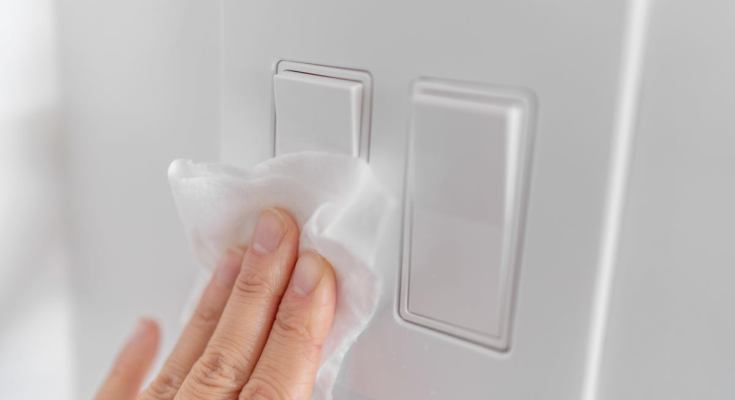
We all have different versions of “cleaning.” For some, the act includes Windex, bleach, and a mop; for others, it means putting away toys, sweeping, and loading the dishwasher. But while “cleaning” can mean everything from straightening up to scrubbing down, when it comes to disinfecting and sanitizing, the definitions, as set by the Centers for Disease Control (CDC), are more clear-cut. And as we find ourselves mid-flu season, with the COVID Omicron variant on the rise, it’s important to understand the difference.
What is sanitizing?
Where the act of cleaning removes food, dirt, organic matter, and dust (and some germs) from surfaces using soap and water, sanitizing takes place after the debris removal. Sanitizing, by the CDC’s definition, lowers the number of germs and pathogens “to a safe level, as judged by public health standards or requirements.” According to Cornell’s Produce Safety Alliance, “Sanitizers are generally considered to be part of a broader group of substances called antimicrobial pesticides.” (They also say, “You cannot sanitize a dirty surface. Cleaning always come first.”)
Sanitizers like this Lysol spray reduce bacteria and viruses by 99.9 percent (when used as directed). Sanitizers should always be applied according to their label instructions and the surfaces allowed to air dry.
What is disinfecting?
Disinfecting goes a step further to kill microscopic organisms such as bacteria, viruses, and fungi using EPA-approved chemicals. It’s worth noting, according to Medline Plus, “disinfecting doesn’t necessarily clean dirty surfaces or removes germs.” But by killing them, it lowers the risk of spreading infection.
G/O Media may get a commission
However, be aware that according to the EPA, “Disinfectants can trigger an asthma attack.” (Disinfectants have a higher concentration of bleach than sanitizers, thus making them more irritating to skin and respiratory function.) Make sure the area is well-ventilated, don’t use harsh disinfectants on children’s toys, and don’t disinfect too often.
What should you sanitize, and how often?
For optimum germ-proofing, routine cleaning and sanitizing of high-touch areas of your home should be done on a daily or semi-weekly basis. Communal surfaces such as countertops, remotes, doorknobs, light switches, computer keyboards, faucet handles, toilet seats and other surfaces that come in contact with bodily fluids should be on the list for regular sanitizing. Additionally, you’ll want to sanitize kitchen surfaces after food preparation (especially when that food prep includes raw meat). And it’s a good idea to regularly reduce germs on the object you may touch most of all—your phone.
What should you disinfect, and how often?
Disinfecting should take place when someone in the house is sick or immunocompromised. The CDC cautions to read the label’s instructions carefully, as “disinfection usually requires the product to remain on the surface for a certain period of time.” (For example, the back of a bottle of Clorox wipes instructs: “Use enough wipes for treated surface to remain visibly wet for four minutes.” Four minutes? Boy, have we been doing that wrong.)
Which brings us back to step one. Cleaning. To safeguard against user error, or simple impatience with spending four minutes continuously wiping down every germy surface in your home, always clean with soap and water first. This process will at least remove some germs, if it doesn’t kill them completely.



